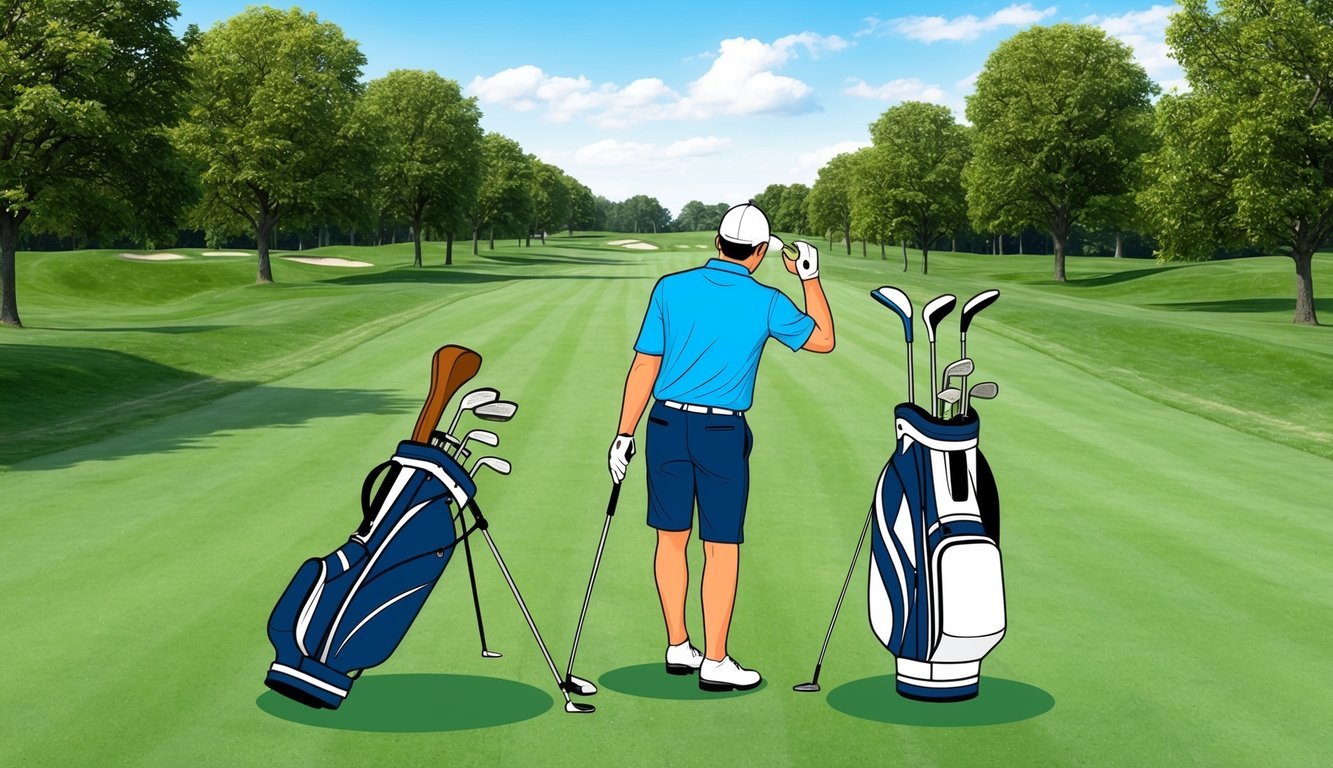Choosing between a 5 wood and a 3 hybrid can feel like a pivotal decision in enhancing your golf game.
Both clubs offer unique benefits and can be strategically advantageous depending on the situation on the course. The primary difference lies in their design and usage: a 5 wood is typically better off the tee with its larger sweet spot, while a 3 hybrid excels in versatility, especially when maneuvering through rough terrain.
Understanding which club to choose can significantly influence your performance and enjoyment on the course.

Incorporating either a 5 wood or a 3 hybrid into your golf bag depends on various factors like swing speed, playing style, and course conditions.
Golfers often find a 5 wood offers better control and distance when hitting straight from the fairway.
On the other hand, a 3 hybrid can glide through tricky lies, making it a favorite for many.
Key Takeaways
- Analyze your playing style to determine ideal club choice.
- Consider course conditions when deciding between these clubs.
- Balance flexibility and control for optimal performance.
Understanding the Basics
Grasp the differences between the 5 wood and the 3 hybrid, focusing on their design and function.
Explore the involved terminology to enhance your grasp on how these clubs can impact your game.
Wood and Hybrid Basics
Fairway woods, like the 5 wood, are designed for long-distance shots, often featuring a shallow clubhead that assists in easier launching from fairways.
Their loft usually ranges from 16-19 degrees, which aids in producing high flight and long distances.
Hybrids, such as the 3 hybrid, are crafted to combine the best features of woods and irons.
They come with a compact head and a loft typically around 19 degrees.
The shorter shaft length makes hybrids more manageable and versatile from various lies.
Their design often helps lift the ball with greater ease, making them ideal for high-handicap golfers.
Golf Club Terminologies
Understanding key golf club terminologies enhances your capability to choose the right club. Loft refers to the angle of the clubface that affects trajectory and distance. Clubhead size influences forgiveness and ease of use, with the 5 wood typically having a larger clubhead than the 3 hybrid.
Shaft length varies between these clubs, with woods featuring longer shafts that can increase distance but may sacrifice control.
These terms and characteristics shape your choice between a 5 wood and 3 hybrid, ensuring they align with your specific playing style and course conditions.
Factors to Consider
When deciding between a 5 wood and a 3 hybrid, you should evaluate your player profile, the ball flight you want to achieve, and the layout of the course.
Each factor can significantly influence your club choice and, ultimately, your game performance.
Player Profile
Your individual skill level and style of play are crucial in choosing between a 5 wood and a 3 hybrid.
If you are a beginner or have a higher handicap, a 3 hybrid might suit you better due to its forgiving nature and shorter shaft length.
This club is easier to handle, which can benefit your accuracy and improve confidence on the course.
On the other hand, more experienced golfers with faster swing speeds may opt for a 5 wood.
This club offers a larger sweet spot and can provide greater distance, which is particularly helpful for lower handicap players looking to fine-tune their game.
Women and men may experience differences due to swing strength, so it’s recommended to try both clubs to see which fits best.
Desired Ball Flight
Your preferred ball flight plays a significant role in this decision.
The 5 wood generally produces a higher ball flight, which can help you achieve longer distances.
If you’re looking to carry hazards or reach elevated greens, this may be the ideal choice for your game.
A 3 hybrid offers a more penetrating flight, which translates to better control in windy conditions.
This club’s design allows for a softer landing, making it a great option for target-oriented shots.
Consider how each club’s characteristics align with your strategic goals on the course, especially when it comes to approach shots and control around challenging green complexes.
Course Layout
The type of course you frequently play should influence your decision as well.
A 5 wood can provide advantages on courses with long par-5s or open fairways, maximizing distance where longer shots are beneficial.
Its ability to achieve greater carry can be instrumental on wide setups.
Conversely, a 3 hybrid is advantageous on tighter, more tree-lined courses.
Its versatility can allow for strategic positioning and accuracy, essential for navigating doglegs and tighter fairways.
Assess how the design and challenges of your usual course match up with each club’s strengths, and adjust accordingly for the best results.
Technical Comparison

When deciding between a 5 wood and a 3 hybrid, several technical aspects can influence your choice.
These include differences in clubhead design, club length, and their impact on your swing and overall performance.
Each factor plays a crucial role in how the clubs perform on the course.
Clubhead Design and Mass
The clubhead design significantly affects how each club performs.
A 5 wood typically has a larger clubhead, providing a more forgiving sweet spot.
This can make it easier to hit, especially from the fairway.
Its size and mass offer higher spin and better control during shots.
In contrast, the 3 hybrid often features a smaller, more compact head design.
This allows for versatility when playing from rough or uneven lies.
Its design helps glide through grass more efficiently, giving you more options during play.
While each has its benefits, the 5 wood generally offers more forgiveness and distance.
Comparing Club Lengths
Club length is another consideration that impacts performance.
A 5 wood usually has a shaft length between 41 and 42 inches, making it advantageous for generating distance due to increased swing speed.
This extra length can aid in achieving higher launch angles, contributing to a longer ball flight.
The 3 hybrid typically measures between 39 and 40 inches.
This shorter length can increase control and precision, making it suitable for tighter fairways or challenging shots.
Despite the differences, both clubs can complement your skill set, allowing you to tailor them to your specific needs.
Impact on Swing
Your swing dynamics are crucial when selecting between a 5 wood and a 3 hybrid.
The longer shaft of the 5 wood helps create more swing speed and, consequently, more distance.
This can be beneficial if you’re looking for extra yards off the tee or fairway.
On the other hand, the 3 hybrid’s design favors players who prioritize control over distance.
It provides a slightly steeper launch angle, which can enhance accuracy.
If versatility and shot-making ability are what you seek, the hybrid presents a compelling option.
Understanding how these differences align with your swing style can help you make an informed decision.
Performance in Different Conditions

When choosing between a 5 wood and a 3 hybrid, the club’s effectiveness can vary based on the playing conditions.
The 5 wood generally offers benefits in tee shots and fairways, while the 3 hybrid shows versatility in rough situations.
Below, you’ll find details on how each club performs in specific conditions, assisting you in making an informed choice.
From the Tee and Fairway
The 5 wood shines when you’re hitting from the tee or fairway.
Its design offers a larger clubhead, providing a lower center of gravity that increases the moment of inertia.
This feature aids in generating a higher trajectory and more roll after landing.
You might find this useful on par 4s and longer par 3s, where extra yardage is advantageous.
Its longer shaft typically offers increased length on your shots.
This is ideal when playing from the fairway, as cleaner lies allow for optimal contact between the clubface and the ball.
Focus on more controlled swings to make full use of the 5 wood’s capabilities from these positions.
Playing from the Rough
A 3 hybrid excels in less-than-ideal lies, particularly when playing from the rough.
Its compact clubhead is designed to cut through challenging terrain where a 5 wood may struggle due to its larger size.
This gives you an advantage if faced with heavy grass or moderate impediments.
The 3 hybrid also offers a higher spin rate, which can help trap air and increase control over the ball’s landing angle.
This is beneficial for tight lies or when you need precision around fairway bunkers.
Allow the hybrid’s unique design to provide lift and distance when the situation demands versatility.
Selecting the Right Club for Your Game

Choosing between a 5 wood and a 3 hybrid depends largely on your playing style and game objectives.
Both clubs offer unique benefits that align differently with various aspects of your play.
Balancing Power and Precision
When it comes to balancing power and precision, a 5 wood might be your ideal choice if you’re looking to maximize distance on your shots.
With a larger club head, this option can generate higher ball speed, offering a significant yardage advantage over shorter clubs.
This can be crucial when you need extra yards to reach the green.
On the flip side, a 3 hybrid excels in offering more precision on your shots.
Its design allows for greater control, which can be a lifesaver when accuracy is more critical than extra yardage.
If your swing tends to stray, a 3 hybrid’s accuracy might suit you better, helping you keep the ball more consistently on target.
Evaluating Club Options
When evaluating club options, consider versatile clubs that fit seamlessly into your personal toolkit.
A 5 wood’s performance excels off the tee and can be very effective on the fairway due to its larger sweet spot, providing increased forgiveness.
It may, however, result in increased shot dispersion, so keep this in mind if consistency is your priority.
In contrast, a 3 hybrid offers versatility by performing well in rough and tight lies.
This makes it a valuable club in challenging conditions, enhancing your capability to adapt to a variety of on-course situations.
Evaluate the pros and cons of each club by testing based on your skill level, personal preference, and the specific demands of your typical rounds.
Consider using a distance chart to objectively compare performance metrics and zero in on the appropriate selection for your game.
Incorporating Hybrids and Woods into Your Set

Choosing between a 5-wood and a 3-hybrid can significantly impact your golf experience.
Tailoring your clubs to fit your strengths in the long game can enhance your performance.
Strategic Club Choices
When selecting clubs, you should evaluate your playing style and needs.
For beginners and amateur golfers, a 5-wood can offer more distance with less effort.
The larger sweet spot makes it forgiving on the fairway.
Conversely, a 3-hybrid can be beneficial in challenging terrains.
This is because its design often includes new technology.
This makes it a versatile option in your golf bag.
These clubs can be effective for long shots and are ideal for players wanting to refine their shot shape.
Understanding Your Long Game Needs
Individualizing your set comes down to addressing your specific golf requirements.
High handicap players may find that rescue clubs like a 3-hybrid provide a better solution for improving accuracy.
It offers more control and can help lower scores.
On the other hand, if you prefer adding height to your shots, a 5-wood can excel off the tee.
Amateur golfers might find that incorporating a mix of both types can maximize their performance, allowing them to adapt to various course conditions.

